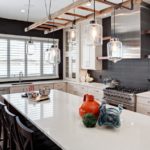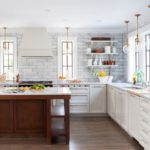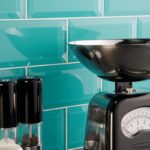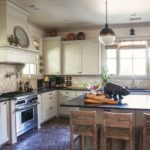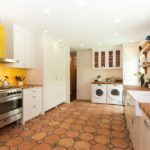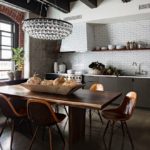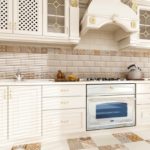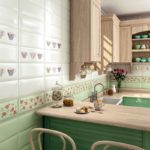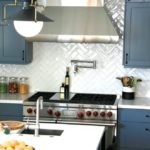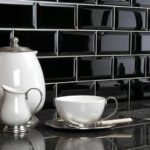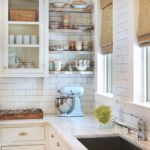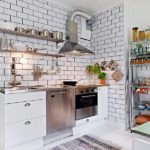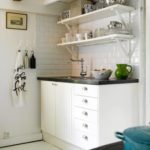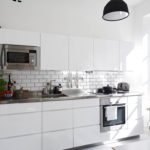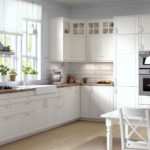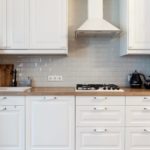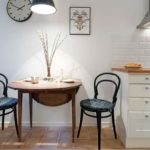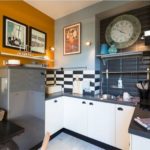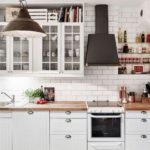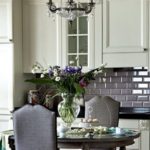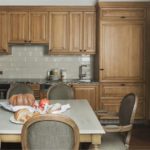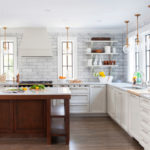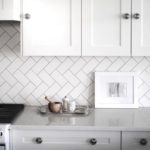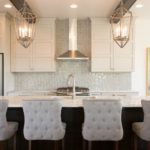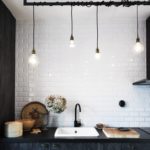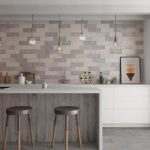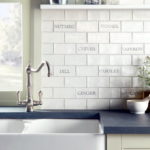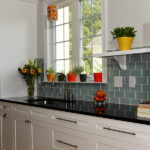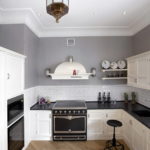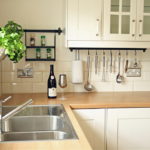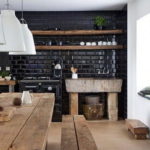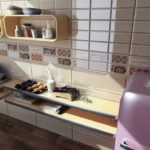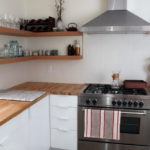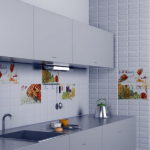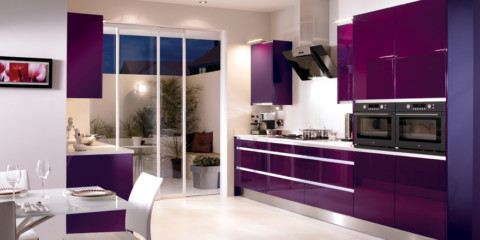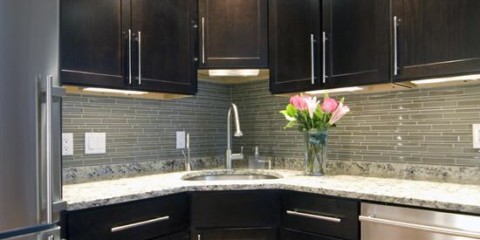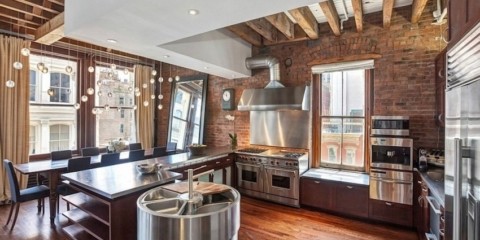 Kitchen
Elite kitchen design. What is he like?
Kitchen
Elite kitchen design. What is he like?
When repairing a kitchen, it is imperative for every person to ask how to finish a working area, is it a kitchen apron? The product protects the walls from fat deposits and contaminants that may occur during cooking. One of the most popular finishing methods is tile "wild boar", it is also called "metro".
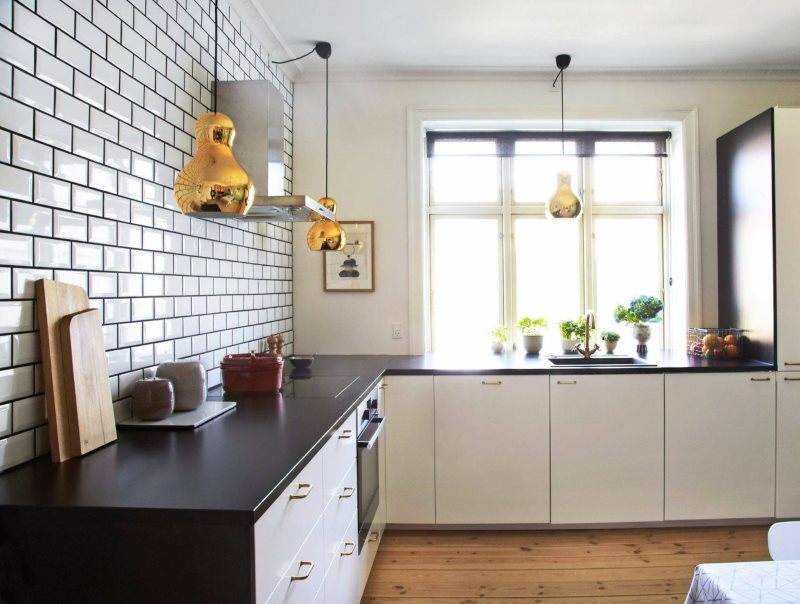
The original appearance of the “hog” allows you to effectively complement the interior of any kitchen
The variety of this tile on the market can satisfy any designer. There is a glazed, thick, chamfered, rectangular or mini. Such decoration will harmoniously fit into any interior and add coziness to the room.
What style does the “wild boar” fit into?
Content
"Boar" will fit into absolutely any style. For example, a lavender "boar" on the workspace in combination with white or dark blue grout and a white kitchen set, floral textiles can take you to Provence. But the combination of beige and brown tiles with a walnut set will appeal to lovers of classics and modernism.
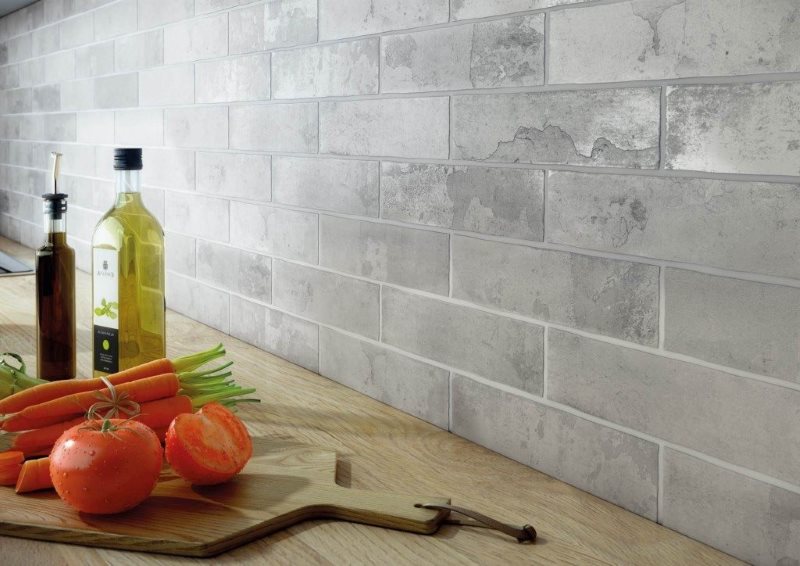
On sale you can find a wide range of colors and simulations of various surfaces.
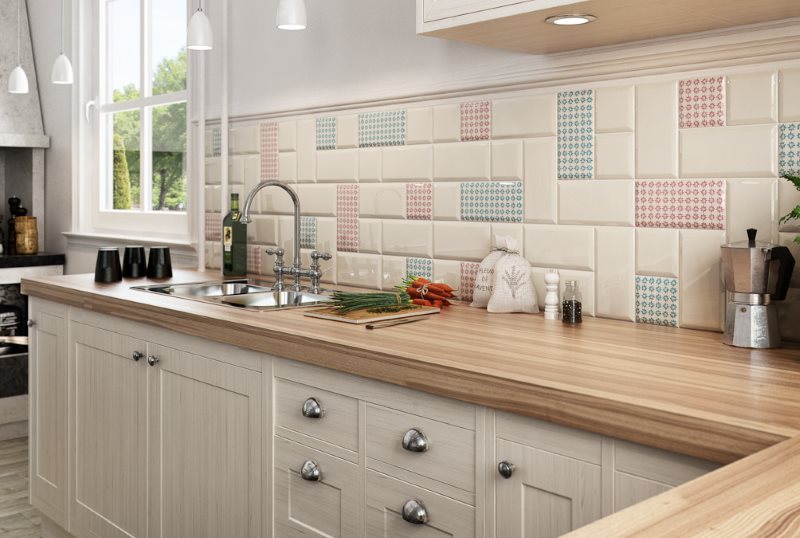
When choosing tile for an apron, focus on the style of kitchen and texture that prevails in the interior
The tile is universal due to an almost unlimited color palette and prints. You can find a classic white version, traditionally used to seeing it in the bathroom, as well as colored tiles with still lifes, cups of coffee, flowers, stylized newspapers, etc.
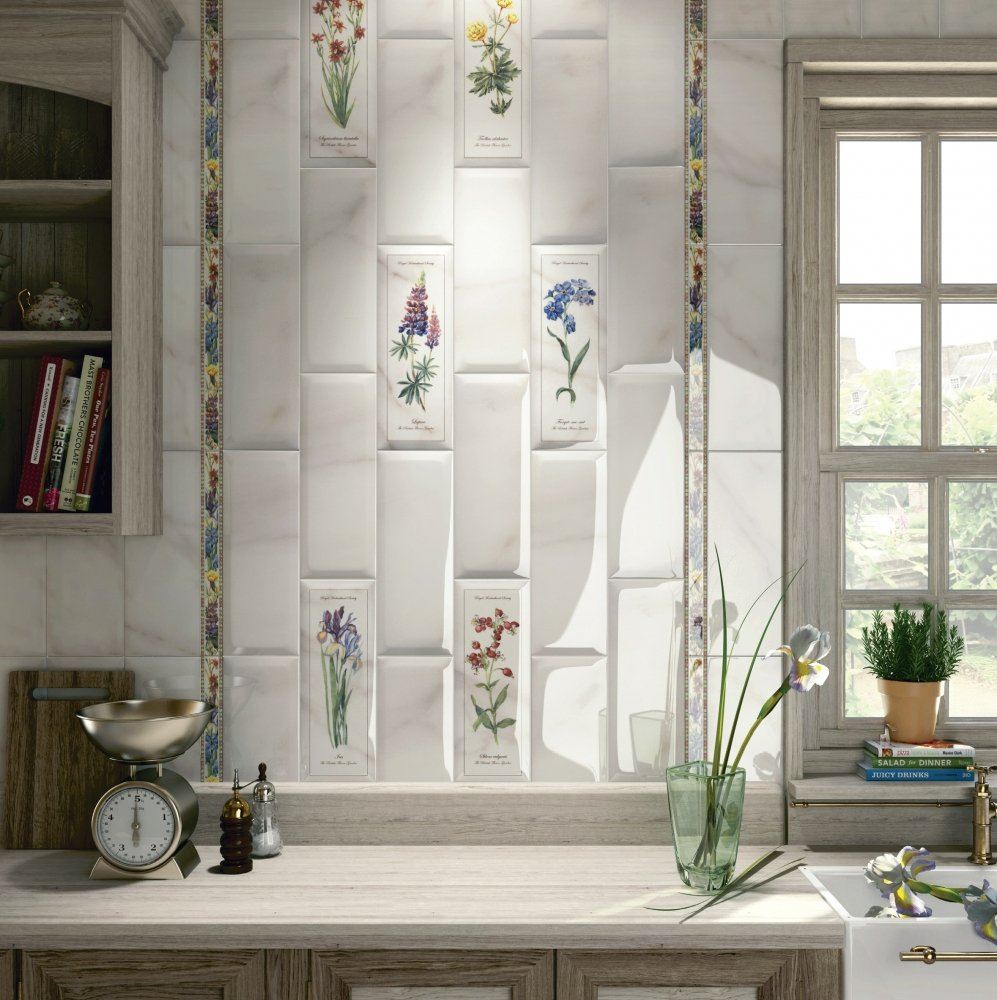
Vertical tile layout with a floral pattern
This solution in the form of tiles with daisies and white classics is suitable for loft-style kitchens. The combination will look elegant and visually expand the space.
Note! Such a tile acquires special charm when using contrasting grouts, rather than tone-on-tone. Contrast colors accentuate the beauty of the tile and perfectly intersect it with the rest of the room.
You can find the “hog” tile on the kitchen apron in almost every house in Scandinavia, if you are a lover of this style, then this workspace option is just for you. In the Scandinavian style, tiles under a natural stone or natural chocolate and nut shades will look especially advantageous.

“Boar” with a coffee touch in the Scandinavian-style kitchen
For the loft style, it is more relevant to take the matte types of "boar" of the minimum size. For such a direction, colors such as: wet asphalt, sand, gray, graphite are suitable. Combining such an apron with geometric lamps and black countertops is one of the best solutions.
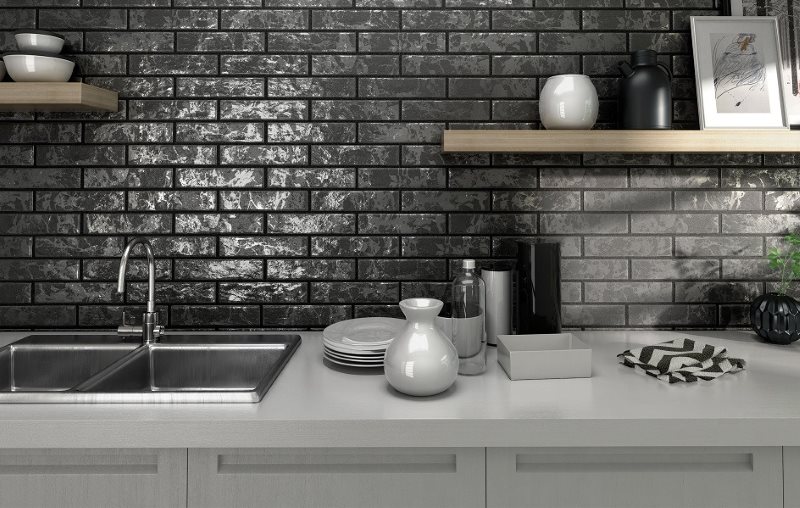
A successful combination of imitation of old stone with wooden shelves
With twin rooms, the dining room-kitchen is perfect for interior decoration in a classic style. The basis of such a design will be massive furniture of dark colors and a "boar" laid with parquet masonry of milky color.
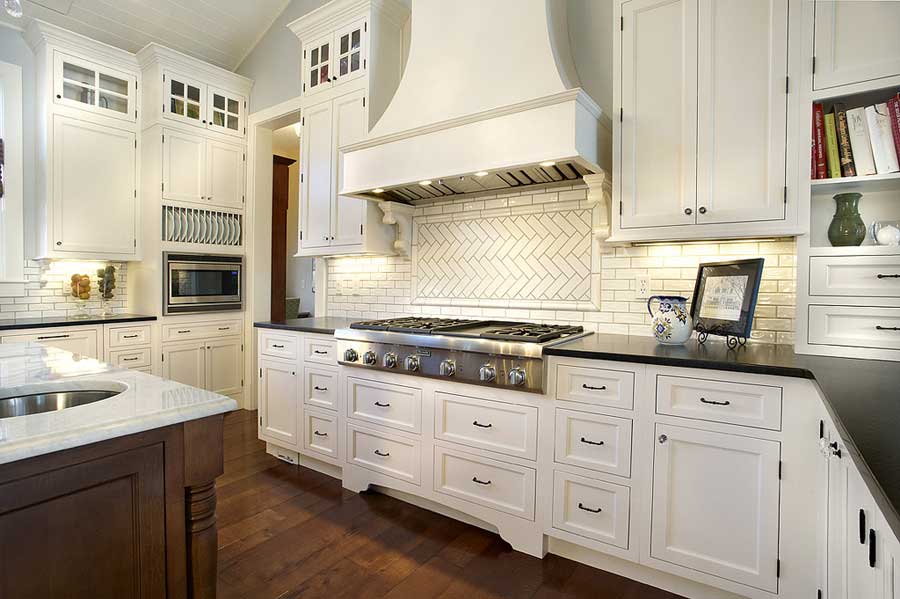
An original panel can be laid out above the hob from the “boar”
What is the "wild boar"? Sizes and types
Among the standard types of such tiles, ceramic, clinker and gypsum tiles can be distinguished. Ceramic - more common due to unpretentiousness in care, versatility and wear resistance. As a rule, its surface is smooth and glossy with minimal relief.
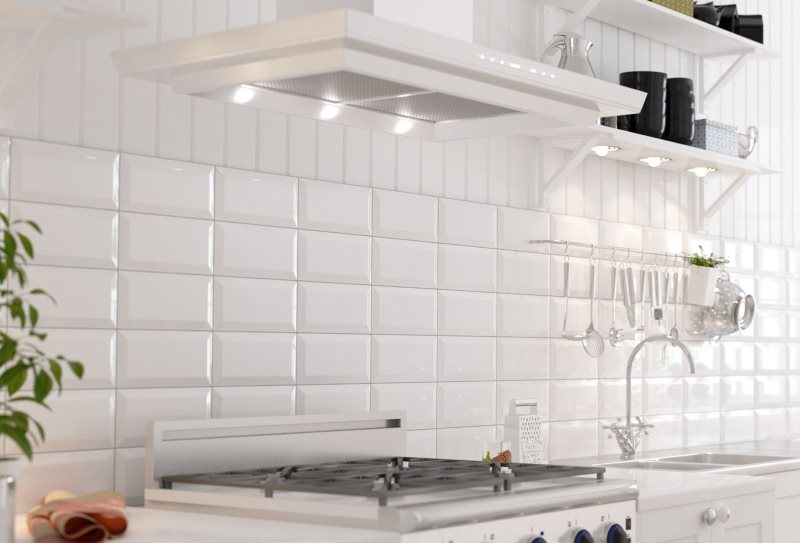
Tile "boar" usually has bevels - beveled edges along the edges of the product

And it looks like an apron made of tiles without chamfers
Note! Ceramic "boar" is not only smooth, but also meets with ready-made patterns. Patterned elements in combination with smooth tiles can create a unique image in the kitchen, it looks especially impressive when combining different patterned elements randomly scattered around the main smooth masonry.
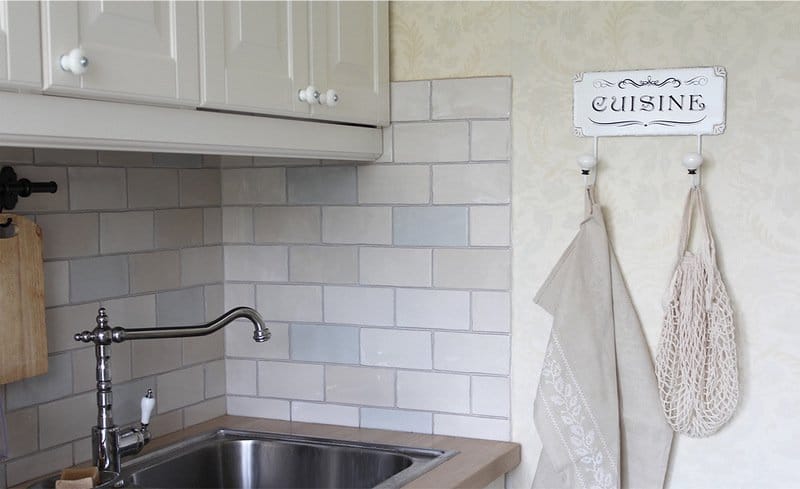
Ceramic tile itself is the most practical finishing material.
Clinker tiles are made of clay, porous structure and very similar to ordinary brick. Clinker is made only in natural shades, it is extremely rare to find white.
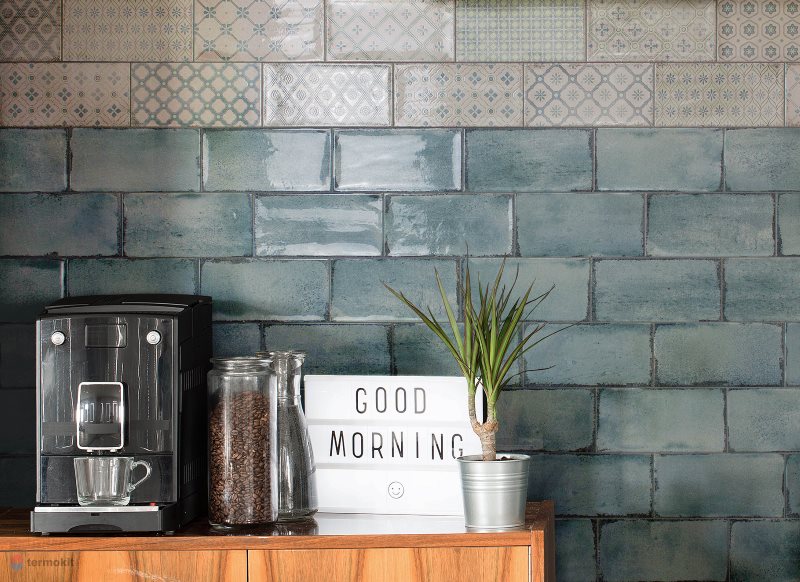
Clinker tiles are the most durable, but also expensive
Important! When choosing such a tile on a kitchen apron, it is necessary to pay attention to the presence of a special protective coating, it will protect the product from water and moisture that are in the kitchen.
Plaster "boar" - the most unfortunate choice for a kitchen apron. The tile is whimsical in care, strongly absorbs moisture, has a short life. It happens, like clinker, only natural colors. The only plus for kitchen repair with such a tile is cheapness.
As for the dimensions of the tile, the length and width of the product directly depends on the manufacturer and varies in width from 6 to 10 cm, in length from 12 to 30 cm. It is customary to consider a product with a length two to three times its width as a proportional "boar".
The most common sizes are:
- 15 by 7.5 cm - as a rule, Italy produces such dimensions.
- 20 by 10 cm - GOST of Russia, the most common size on the market.
- 30 by 15 cm - this size is often made in China.
- 30 by 7.5 cm - the size imitating the size of a brick.
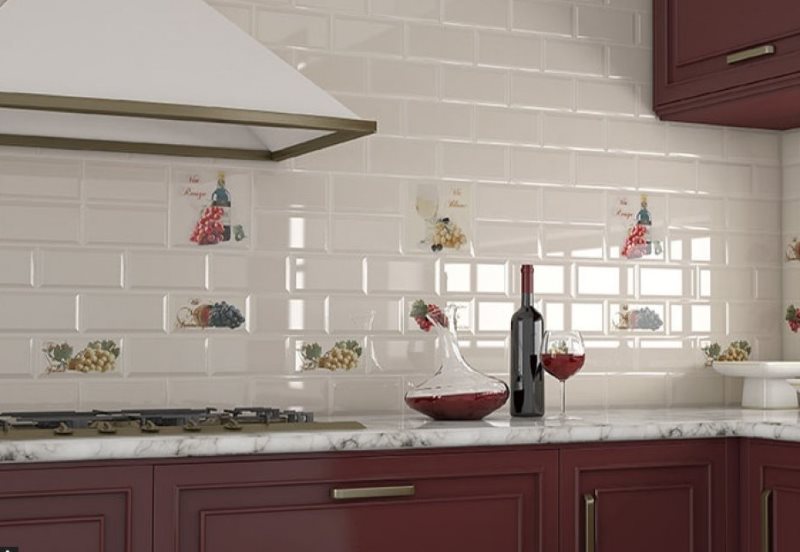
In the photo the most common size of the “hog” is 20x10 cm
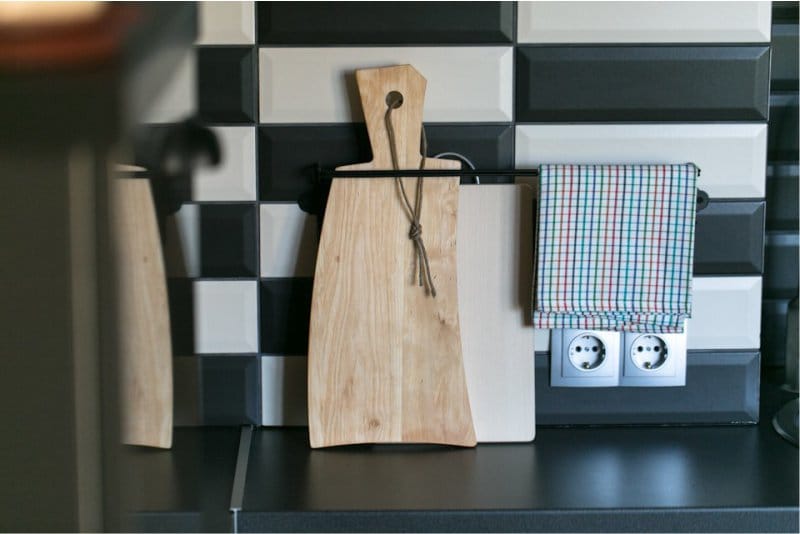
And this is an example of ceramic tiles measuring 30x7.5 cm
How to enter a "boar" in the interior
First of all, when designing a kitchen, you should choose the method of laying such tiles.
Important! When purchasing tiles, you must add plus 10% to the required amount in case of uneven trimming or manufacturing defects. The tile is always cut in advance as the adhesive mixture is quick-drying.
A simple but elegant method of “brickwork” is considered habitual or even ordinary, when the tiles are placed horizontally and each next row is laid with an offset on the floor of the tile relative to the previous one. This installation option is universal and will be combined in any color scheme.
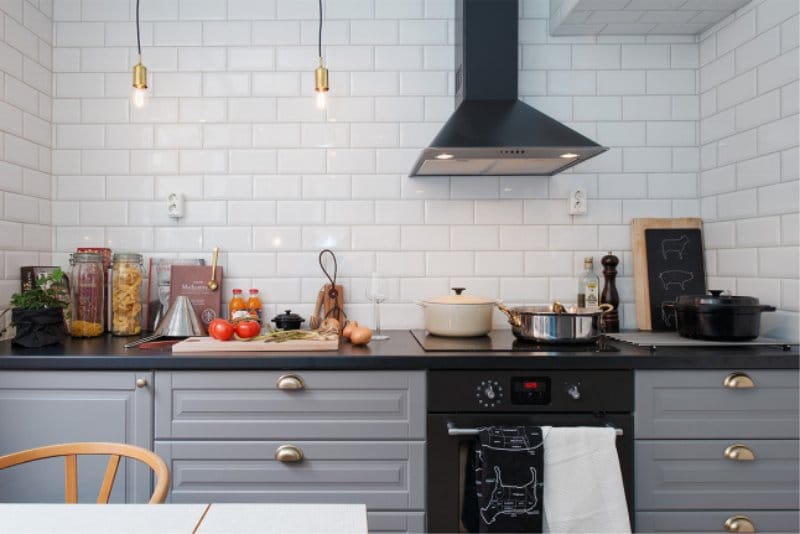
The traditional laying of the “boar” tile imitates the “runaway” brickwork
In addition to “brickwork”, the option of horizontal or vertical laying without offsets will look advantageous. Rows go parallel to each other, usually in such a layout grout choose a tone in tone tiles. A horizontally laid white kitchen apron with mosaic tiles on the floor of walnut and chocolate flowers will be beautifully combined.
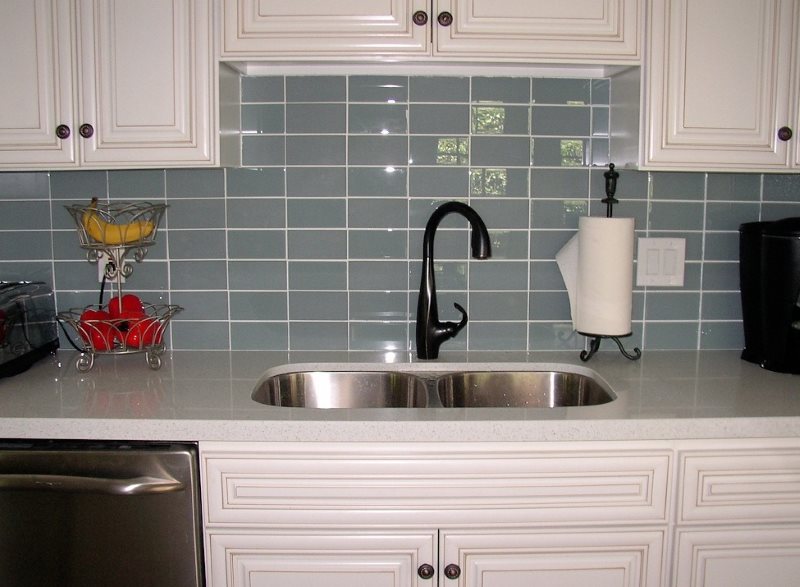
When choosing “seam to seam” laying, you can focus on the seams by highlighting them with a grout of contrasting color
If you spread not only the working area with a “boar”, but also the entire wall, then some rows can be laid vertically. Or lay the apron in a zigzag, and the remaining surface horizontally without offsets.
Zigzag-type masonry is made with an offset of 45 degrees, popularly known as the "herringbone". The masonry, which is the most expensive and difficult to work, can add original patterns to the kitchen. Most often, such an application of "boar" in an apron is combined with other geometric lines in the design of the kitchen.
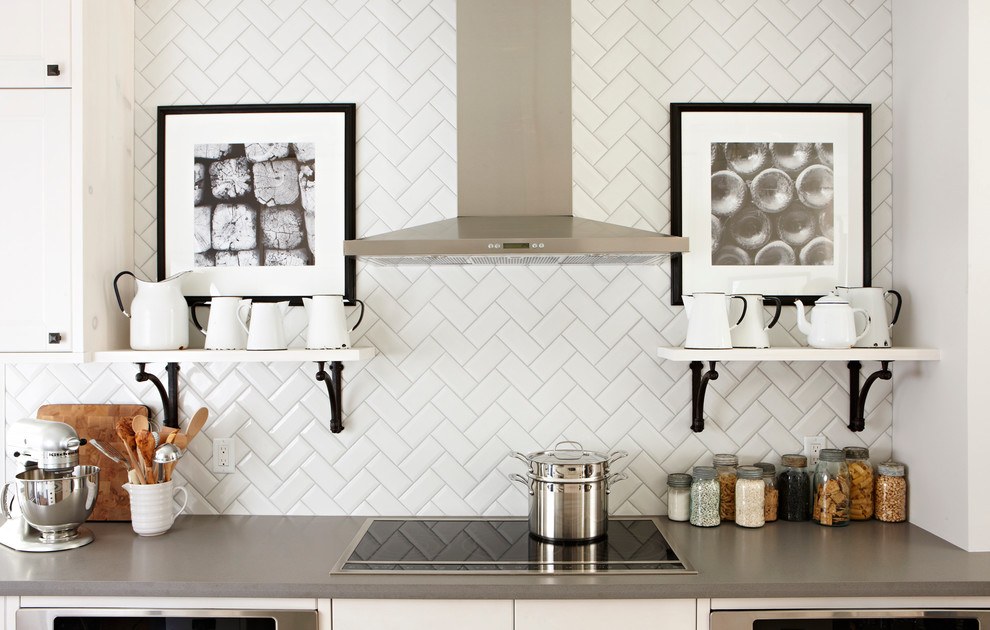
Tile "boar" provides many laying options
If you want to do something original and unusual on the workspace, you can view the options for laying parquet. The tile in size is very similar to parquet boards and that is why the adaptation of the drawings will not cause difficulties.
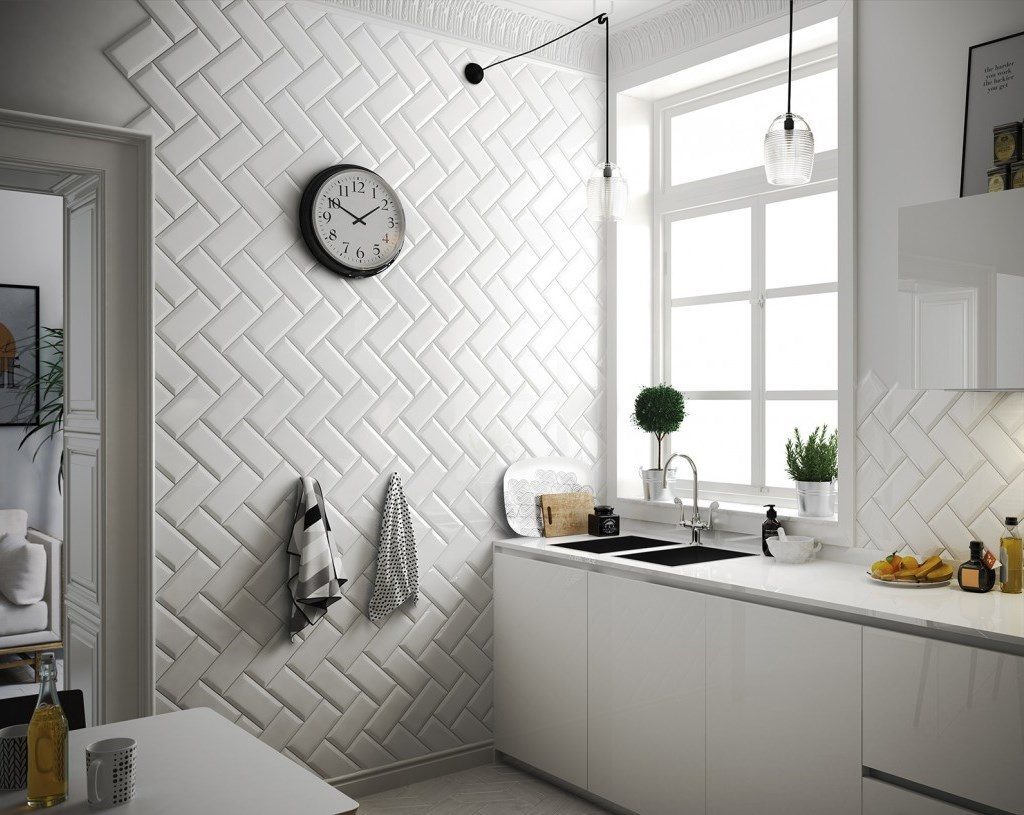
Christmas tree - one of the options for parquet laying
Color colors "boar" on the kitchen apron
The kitchen is the place where everyone is accustomed to making the color of the apron several tones lighter than the main color of the walls, but these are long-obsolete trends.
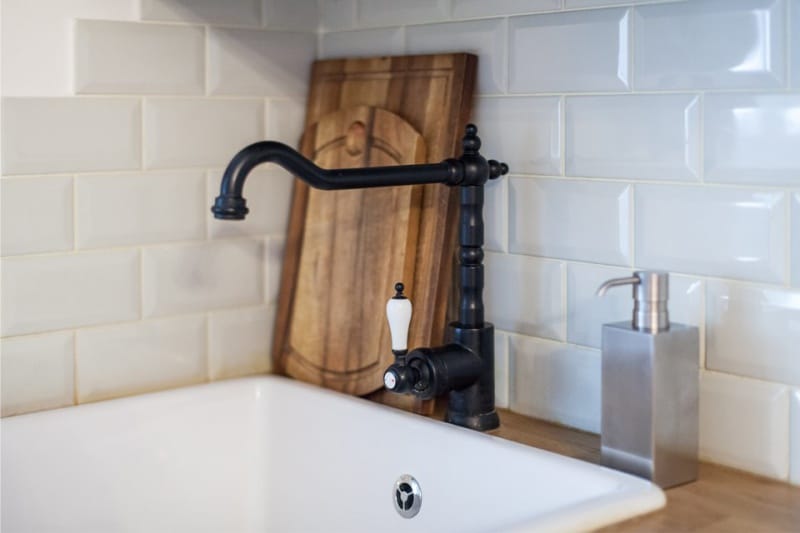
White, beige and cream - the most versatile colors for a kitchen apron
A combination of black tiles and a white headset will look unusual and bright. If you like a rustic style - just add a green color to the apron. The red cladding with blue grout is suitable for lovers of contrasting colors, but will lead away from the usual black-and-white or red-black version.
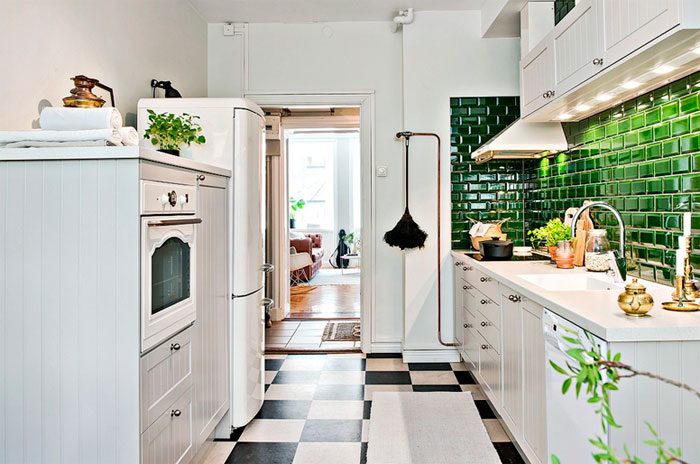
Bright green tile apron with 3D effect
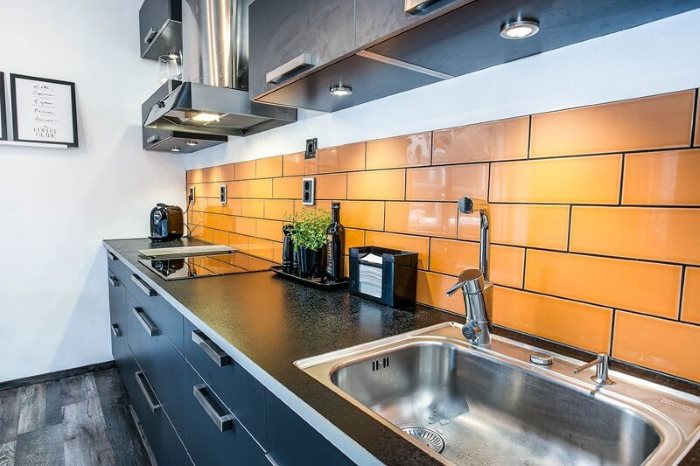
Glossy apron with contrast grout between tiles
Unusually looks a multi-colored "brick" masonry on a kitchen apron, especially in pastel and powdery colors. It is important to remember that in this version of the colors should be in moderation (maximum four), otherwise the composition will be oversaturated and quickly get bored.
Again, the gradient comes into fashion, if you choose the shades of the same color, from dark to light and lay the “zigzag” masonry, you can visually make the room more spacious and extend the ceiling.
Note! The gradient does not tolerate complex designs and a large number of furniture, this option is suitable for lovers of simplicity and minimalism.
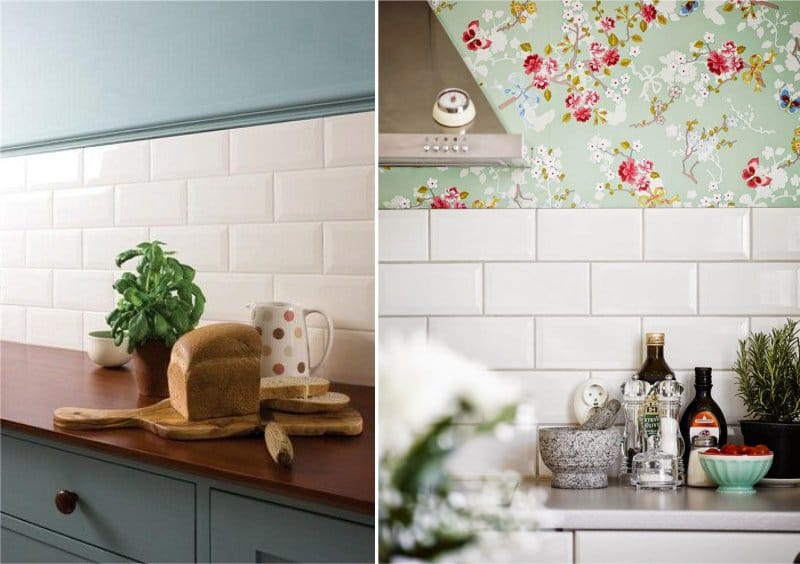
The appearance of the apron and the cost of laying depend on the thickness of the seams - the thinner the seam, the more difficult it will be to lay the dies evenly
In order to successfully enter the "boar" into the interior, you must adhere to the following rules:
- Cream, beige, white - universal colors for the lazy. They fit absolutely into any interior and will suit any style.
- With bright headsets, bright aprons look spectacular. For example, white furniture and a bright yellow apron will give a feeling of summer, by the way, this is the best solution for dark kitchens with a lack of lighting.
- Matte "wild boars" look good with furniture made of natural wood of light breeds.
- Choose the right grout. Grout functions not only as a protection of the seams and edges of the tile, but also as an important part of the decor, it will help to shade and dilute the basic colors of the room.
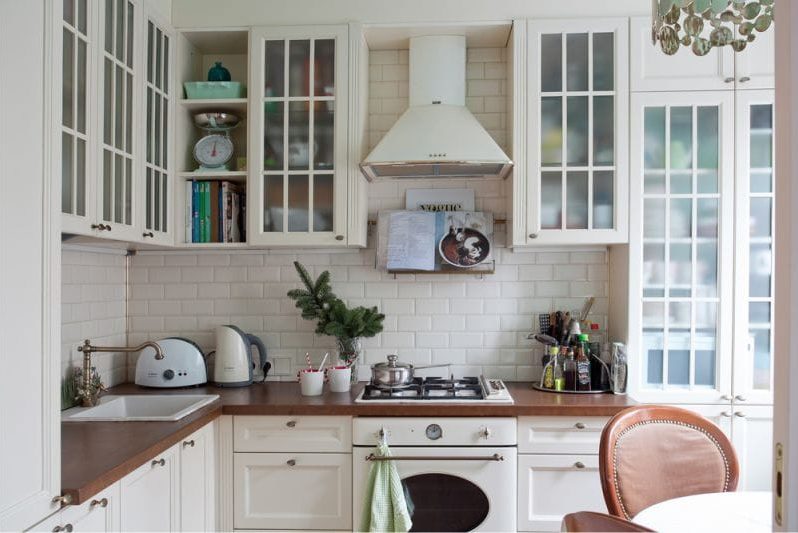
Whatever color you choose to grout, the composition should be waterproof and designed for frequent washing
Important! Do not save on the cost of grouting, cheap tends to wash, crumble and lose its color. The best choice for the kitchen will be an epoxy-based grout.
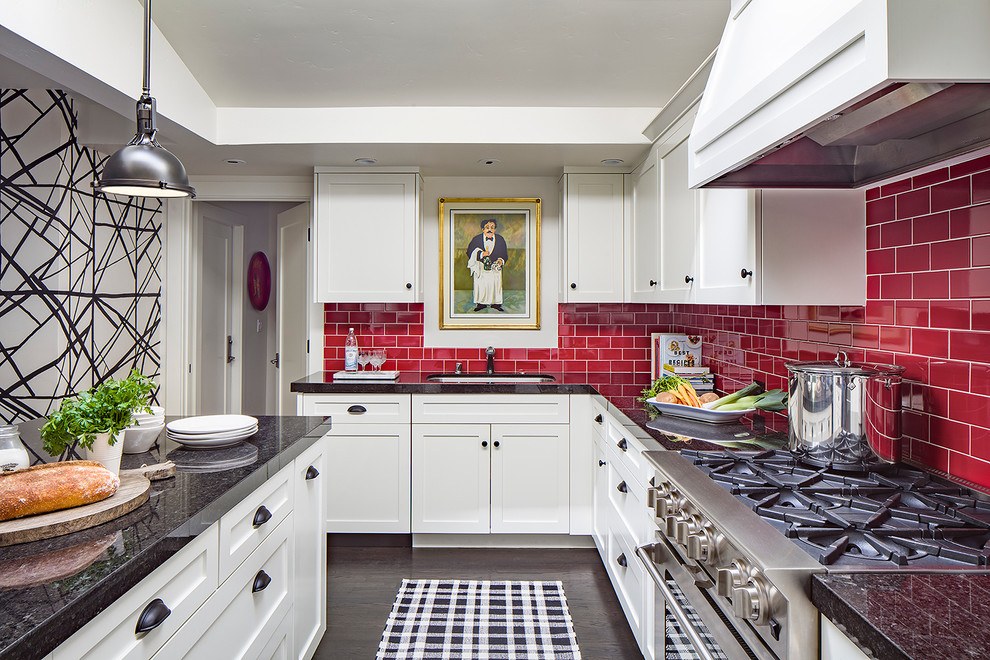
Red “boar” on an apron in a modern kitchen
Tile Care
The material itself is very practical to use for several reasons:
- The tile does not absorb dirt and is easy to clean.
- High resistance to humidity and temperature changes.
- Environmentally friendly material.
- The material does not absorb dust and odors.
In the care, the “boar” is not whimsical and any dirt can be easily cleaned with a damp sponge. In this case, there will be no changes in the color or texture of the surface due to a special protective coating.
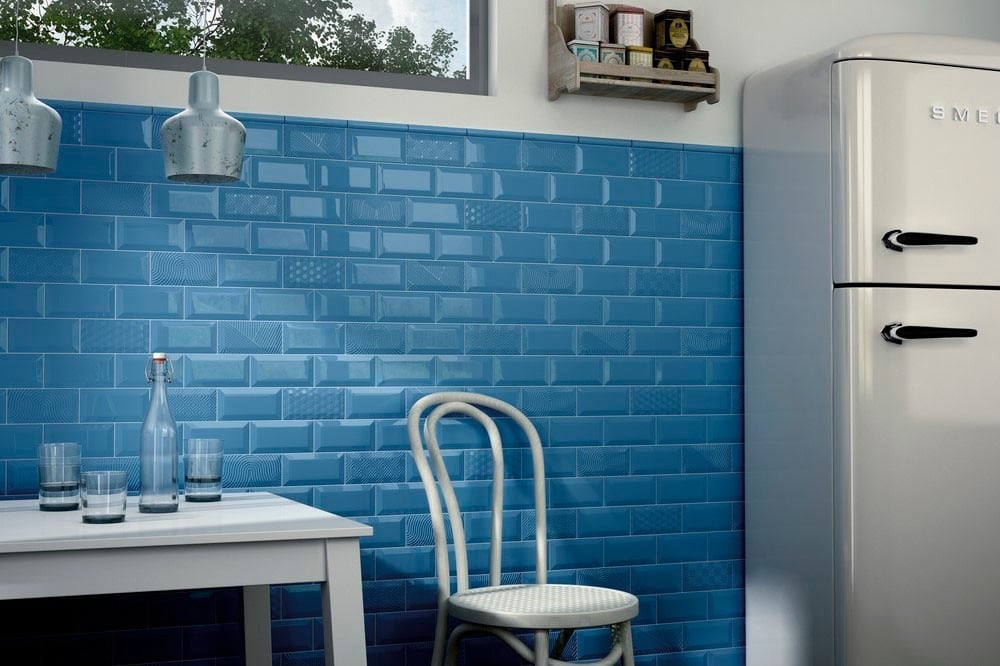
It’s easiest to care for glossy tiles.
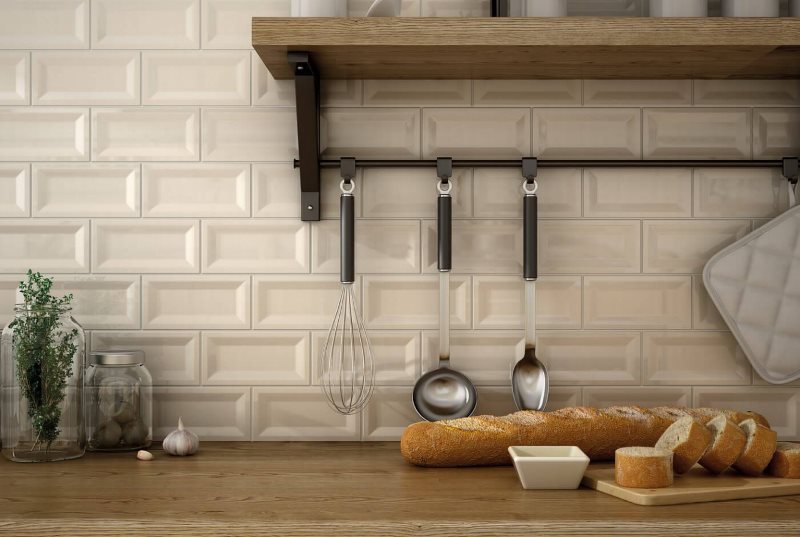
Embossed tile is harder to wash and longer
The only drawback in the use of such a finish will be small joints and seams into which the dirt will clog. Removing them takes a little more effort than from the main surface and requires additional tools, for example, degreasing detergent or carbon sprays.
Thus, when decorating the apron of the working area in the kitchen, it is recommended to purchase a small “boar” tile. A huge assortment of such material will allow you to choose the necessary options. Various combinations of styling can even make something unique from a classic white and beige tile. In addition, such a lining will perfectly protect the surface from dirt and grease.
Video: “Boar” in the interior of various kitchens
